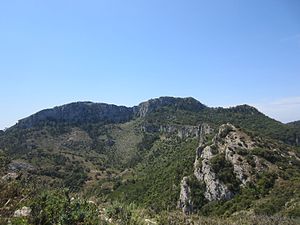Cardó Massif
| Cardó Massif | |
|---|---|
 Serra de Cardó mountain range seen from the south near Benifallet | |
| Highest point | |
| Elevation | 942 m (3,091 ft) |
| Coordinates | 40°54′02″N 0°35′36″E / 40.90056°N 0.59333°E |
| Dimensions | |
| Area | 340 km2 (130 sq mi) |
| Geography | |
| Location | Baix Ebre, Catalonia, Spain |
| Parent range | Catalan Pre-Coastal Range |
| Geology | |
| Mountain type | Mostly Calcareous |
| Climbing | |
| First ascent | unknown |
| Easiest route | Drive from Rasquera or El Perelló |
The Cardó Massif (Catalan: Massís de Cardó, IPA: [məˈsiz ðə kəɾˈðo]; Spanish: Macizo de Cardó), also known as Cardó-Boix Massif, is a mountain massif in the Baix Ebre comarca, in Catalonia, Spain. This massif is composed of a number of mountain ranges located on the left side of the Ebro river near Tortosa. The massive calcareous cliffs of the Serra de Cardó form the eastern side of the spectacular gorges through which the Ebro River winds its way in the final stage of its course, separating the Ebro Valley from the Mediterranean coastal area.
The ranges cover an area of over 340 km2, extending from Rasquera in the north, to Benifallet in the south and eastwards through El Perelló until reaching the Mediterranean Sea between L'Ampolla and L'Ametlla de Mar. Highway N-340 crosses the eastern side of the massif and Autopista AP-7 skirts the easternmost foothills by the seashore.
All the ranges are part of the
Balma de Cabrafeixet is a prehistoric site below the Morral de Cabrafeixet escarpment (753 m) with cave paintings. The entrance to the cave has been closed with an iron bar door to prevent vandalism. Another cave, Cova de la Mallada, is located nearby[2]
There are many wind turbines located on different ridges of the massif, the Parc Eòlic de les Colladetes and the Parc Eòlic de les Calobres.[3]
Ranges
The main ranges of the massif are:
- Autovia C-12 cuts across the westernmost end of the range, above the Ebro Gorges. The mineral water coming from springs near the ancient monastery located at the heart of the range was one of the first waters to be bottled in Spain.[4]
- Serra del Boix, highest point Buinaca 764 m. The slopes are covered with low bush, among which Buxus (Catalan: Boix) predominates. This range occupies a central position in the massif and in some geographical works gives its name to the whole massif. The particular high rocky area with original rock formations where the highest peaks are located is known as "Les Moles". There are wind turbinesatop the main eastern ridge.
- Like the Serra del Boix, the higher altitudes often have snow in the winter.
- Montaspre, highest point 527 m, the southwestern foothills of the Serra de Cardó range, rising near Bítem.
- where many small country cottages have been recently developed.
- Serra de les Veles, highest point Coll de l'Àliga 94 m, is formed by the low southernmost foothills of the massif. This small range is crossed by highways and has been gutted by sand and gravel extraction, where the pits are used as landfills. These lower ranges very rarely have snow, even in cold winters.
-
Les Moles area:Cabrafeixet on the right, seen from the north between El Perelló and Rasquera
-
View of 942 m highXàqueraor La Creu de Santos, the highest summit of the range
-
Font del Teix spring in Serra de Cardó
-
Montaspre in the Cardó Massif
-
View of the Serra del Boix/Serra de Gaviots mountain ranges from the south with some snow on the higher altitudes
-
Wind farms on Serra de Gaviots
-
Serra de Collredó range seen from an orange grove in Mianes
-
Serra de Collredó seen from the east. In the background thePorts de Beseit
-
Sand mining in Serra de les Veles
Monastery
The
In the late 19th century the monastery was transformed into a spa, which became a very successful place among the Catalan elite until the Spanish Civil War. By mid 20th century, only a water bottling plant was functional in the area.
Recently there was a project to transform the ruined former monastery and spa premises into a
The small abandoned hermitages scattered about the area close to the former monastery, some of them perching atop karstic rock needles, are popular with hikers.[7]
See also
- Catalan Pre-Coastal Range
- Mountains of Catalonia
References
- ^ Mapa Topogràfic de Catalunya - Institut Cartogràfic de Catalunya
- ^ enciclopèdia.cat - Morral de Cabrafeixet
- ^ Parc Eòlic de Les Colladetes
- ^ Estudio comparativo de las aguas minerales naturales de España
- ^ "Tortosa Medi Ambient -Pla d'ordenació urbanística municipal" (PDF). Archived from the original (PDF) on 2016-03-03. Retrieved 2011-04-24.
- ^ El balneario de Cardó se convertirá en hotel de lujo tras una inversión de 45 M€
- ^ Tinet - La Vall de Cardó,; Images














